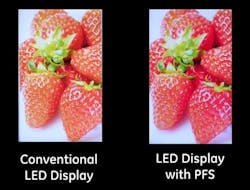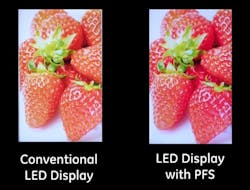Narrowband red light conversion allows LCD-based TVs, monitors, and mobile devices to present richer red colors, but GE will reserve the use of the technology for its own lighting products.
GE Lighting has announced volume manufacturing of its TriGain family of potassium fluorosilicate (PFS)-based phosphors for LED-based backlighting in displays, along with a broader licensing program for packaged LED manufacturers. The PFS technology enables LCD-based TVs, monitors, and mobile devices to product richer reds with truer color control. The technology also could have major implications in LED-based general lighting but for now GE's licensing program does not cover such usage, with the company planning to use the technology for its own lighting products.
Most LED backlight units for displays today use phosphor-converted white LEDs that are based on a blue pump or LED and a nitride-based phosphor mix to add the green and red energy into what appears as white light. That technology is arguable superior to the previously-used fluorescent backlights, but even the LED-based technology includes compromises. Most red phosphors have a relatively wide emission band. The result can be reds presented on a TV with a washed-out or even an orange tint. Meanwhile, some of the emitted energy falls above the human visual sensitivity range and essentially represents wasted power.
The red dilemma has led manufacturers of quantum dots (QDs) to target the display and lighting sectors, especially with narrowband red dots. We covered the progression of QDs in late 2013. And there are high-end TVs on the market that use the technology. But QD lifetime trails phosphors and the manufacturing cost remains high.
GE says that its PFS phosphor offers the narrowband spectra along with cost and lifetime characteristics more akin to the mainstream LED technology. The company has worked with PFS technology for many years and has significant patents in the area.
Last year, GE began to talk more about the advantages of PFS in displays with the nearby photo depicting the advantage in a display. The company licensed Sharp and Nichia to use the phosphor in LEDs sold into backlighting applications. And GE says that there are consumer products on the market that use the phosphor today.
Now GE will manufacture the phosphor powder itself to ensure a reliable source for the LED manufacturers that license the technology. "This breakthrough was only possible through GE’s prevailing leadership in the advancement of LED technology," said Jerry Duffy, GE Lighting global product general manager. "Adding to the breakthrough is GE’s proprietary improvements to phosphor synthesis, including decreased particle sizes, higher quantum efficiencies and longer life when compared to standard PFS. Many devices currently on the market offer lower-quality red components in LED — what GE has achieved technically will turn the tide toward more vibrant color in a range of consumer electronics."
So why not use PFS in lighting? Actually, it could be a good match for all solid-state lighting (SSL) product development. As we have covered many times, warm-white light with good color rendering requires more energy at the red end of the color spectrum and almost always a penalty in terms of efficacy, in part because of energy radiated at invisible infrared bands.
Cree addressed the issue by adding monochromatic red LEDs into some of its TrueWhite-branded products. And Osram Opto Semiconductors developed similar technology with its Brilliant Mix platform.
Recently, however, improved phosphor formulations have resulted in broader availability of warm-white LEDs with high CRI and relatively minor efficacy penalties. The GE TriGain phosphor could perhaps improve the situation further. The company also posted a video on the advantages the technology offers in lighting.
For now, however, GE plans to reserve the use of the technology in lighting for its own use. It's not clear how PFS might come to market in GE Lighting products. GE does not manufacture LEDs despite having invented the first LEDs. GE could have an LED manufacturer make LEDs for GE's exclusive use. Or the company could deploy PFS on secondary optics as is done with remote-phosphor designs.







